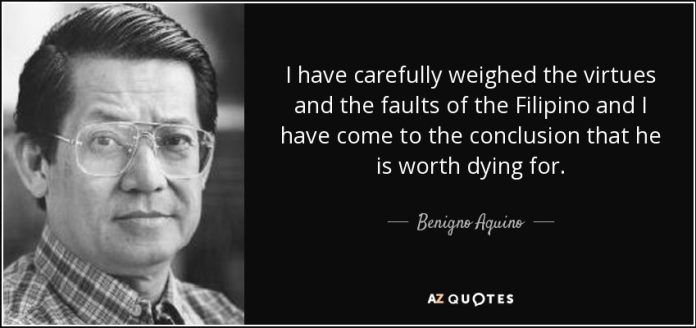Marcos Jr. has turned the memory of the violent death of Ninoy Aquino into “holiday economics”, so with the violent deaths of other heroes whose memories we celebrate. Such a move by this President does not help at all in the valorization of their significance in our history as a country. On the contrary, it desecrates their memory.
Before being vilified by Duterte and his minions, Ninoy Aquino was looked up to in my generation. He was considered a “martyr” — someone who offered his life for the freedom of the Filipino people. All of us were glued to our TV sets when he landed at the airport and minutes after, gunshots were heard. He did not die for the “faith” like Lorenzo Ruiz or Pedro Calungsod which the Catholic Church elevated to the altars. But he voluntarily offered his life for freedom.
Historical revisionism, the well-funded troll machine and, more recently, holiday economics wanted to change all that. These moves by this and past administrations dilute the meaning of their martyrdom.
Against this trend, I would like to celebrate Ninoy’s death (August 21) and the death of other Filipino heroes (August 26). Let me situate their deaths in the shifting concepts of martyrdom all throughout history.
Martyrs are traditionally called believers who died out of hatred for the Christian faith. There are two perspectives of the martyrdom narratives in the different epochs of Christian history: from the dominant perspective of those who hold power, that is, from the official storyline of the Empire, and from the persecuted Christian communities themselves.
From above, they were killed because they were criminals, threats to existing social order, and disobedient to the laws of the regime. They were red-tagged and then killed. From below, these martyrs were killed because they were faithful to their human and Christian calling even in the face of hostile powers. From those who believed in their cause, the martyrs were real heroes.
The historiography of Christian martyrdom shifts emphasis according to different times.
1. HATRED OF THE FAITH
First, the Christian martyr is one who died “in odium fidei” (in hatred of the faith). When the Roman Empire was threatened by the new Christian movement, the believers were sought out as criminals. Before they were led to the slaughter, they were asked if they believed in Christ; and if they were members of the Christian sect. The main sign of martyrdom was their personal confession of the faith as the earliest accounts of death of famous martyrs like. Polycarp, Apollonius, Perpetua and Felicity, Cyprian, show.
2. HATRED OF CONSCIENCE
The second step in martyrdom’s journey is “in odium conscientiae” (hatred of conscience). In the medieval period, when the Catholic church exercised dominant hegemonic rule in collusion with worldly powers, or better still when Christianity became political power itself, martyrdom was seen as a denial of individual conscience for its non-acquiescence to the dominant power. Though there were still missionaries in foreign lands who were killed in the name of hatred of the faith as they met new cultures and nations, there were also martyrs within Christianity itself, for example, the trials of Joan of Arc, Jan Hus, and others.
“They were assailed with dogma, Bible, obedience, judgment, and another salvation. Worse, they were regarded as negative figures to the degree that they were critical, and people did not hesitate to attribute the conflicts which broke out in the mother church to their impiety.” They were victims of the system’s hatred of conscience (odium conscientiae). They prefer to uphold the Reformation’s emphasis of fides as “personal trust” over and above Tredentine’s fides as “doctrinal system”.
3. HATRED OF JUSTICE
The third development is a rethinking of martyrdom beyond the previous perspectives towards deaths caused by people’s hatred of justice (in odium justitiae). In the 1983 Concilium issue, Rahner argues to broaden the traditional concept to include “a death suffered in an active struggle for the Christian faith and its moral demands (including those affecting society as a whole).” Twenty years after, Concilium issued another volume on rethinking martyrdom. Jon Sobrino argues that martyrs are those who followed the demands of Jesus up to his violent death as the culmination of a life of praxis of justice and defense of the poor and the oppressed.
“In the way deaths come about in the Third World today, martyrs are above all those who die like Jesus because their lives, words, and praxis have been essential – allowing, of course, for matters of degree – like those of Jesus. They suffer a violent death for being like Jesus. This is why I call them ‘Jesus martyrs’… In this case, Jesus martyrs are not, strictly speaking, those who die for Christ or because of Christ, but those who die like Jesus and for the cause of Jesus.”
Oscar Romero, Dietrich Bonhoeffer, and Martin Luther King, Jr are prominent examples of these “Jesus martyrs” coming from different Christian denominations. Sobrino differentiates between classical martyrs; ‘Jesus martyrs’ like Oscar Romero or Dietrich Bonhoeffer; and the “crucified peoples” of the Third World who die en masse without recognition and dignity as victims of political repression, ethnic cleansing, or poverty.
4. HATRED OF LOVE AND COMPASSION
The fourth step in rethinking martyrdom is death out of hatred for the love of neighbor (odium amoris) – taking some cue from Sobrino’s last category. These contemporary martyrs whose lives are far from the prominent lives of Romero or Bonhoeffer, whose deaths maybe not as dramatic, whose lives were so ordinary and commonplace and unheroic but met equally violent deaths as they expressed their commitment and fidelity to their families and friends. Many of them were ordinary sons or daughters, fathers or mothers – working with meager incomes for their families. Some of them were not even pious and staunched defenders of the faith. They were merely doing what an ordinary human person is expected to do. Yet their violent deaths are signs of their Christian love for their neighbors. The narratives are endless if we collect them.
What I would like to argue is the recognition of non-heroic martyrs, persons who were not resolved to offer their lives for the faith or for lifelong fidelity and witness to Jesus. Their lives were far from exemplary; their violent deaths were not voluntary, even hesitant. If they were given a chance to escape, they probably will. But their dedication and fidelity to their loved ones and neighbors were ultimately non-compromising. Because of this, they met their violent deaths. As one theologian describes them as “killed by hatred of love”.
5. WITNESSES TO LOVE
Martyrs are ordinary people who are “witnesses to love.” Recovering the fundamental insight of St. Thomas in Summa Theologica II-IIae, Question 124, the Spanish theologian, José Ignacio Gonzáles Faus, argues that martyrs are persons who are “witnesses to the perfection of love”.
In article 5, Aquinas asked whether faith alone is the cause of martyrdom. He answered in the positive; however, the so-called faith is not only about inward belief but also external profession which is not only articulated in words but also in deeds (referring to James 2:8). He brings in the martyrdom of John the Baptist which was caused not him denying his faith but by denouncing the evils the Herod has done. Aquinas, in a previous article (art. 4), writes that a martyr is one who “does not abandon faith and justice even when faced with imminent death”.
Faus suggests three points. First, martyrdom in the Church must be assimilated into the martyrdom of Jesus, that is, dying not so much consciously for Jesus as like Jesus. Second, martyrdom is the proof of love. He quotes Vatican II to say: “The Church therefore considers martyrdom as an exceptional gift and as the highest proof of love” (Lumen Gentium 42, 3, italics mine). Third, martyrdom shall be seen not so much from the motives of those who kill but from the motives of the victim. The early church tradition talks about the martyr as a witness to God’s love and fidelity and concrete love to the neighbor.
Witnessing the life and dangerous memory of Jesus becomes a grave threat to the dominant power of the Empire. The victims turned themselves into witnesses of love and justice for which reason they have been killed.
You don’t honor these deaths by holiday economics.
Father Daniel Franklin Pilario, C.M., is the President of Adamson University in Manila. He is a theologian, professor, and pastor of an urban poor community on the outskirts of the Philippine capital. He is also Vincentian Chair for Social Justice at St. John’s University in New York.









